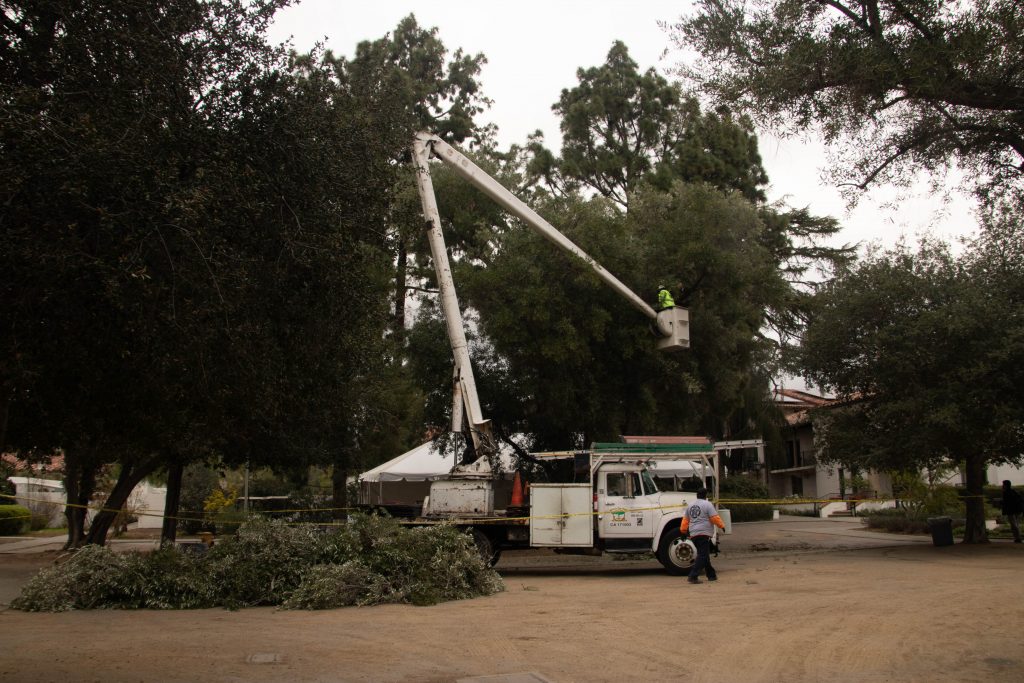Lauren Marler ’24
Staff Writer
Each day, Scripps students study or chat with friends under the canopies of Elm Tree Lawn, or really anywhere on our beautiful, tree-filled campus. It is hard to imagine Scripps College without its plethora of shade-providing trees. After losing trees in the recent windstorm, it is even more important to pause, look up, and appreciate the wonderful trees that are still standing.
Joya Salas, the Landscape Operations Manager at Scripps College, explained that three trees near Jaqua were impacted by the wind– one being a large Italian Cypress planted right by Toll. This tree was in the original planting plan of the college, as Toll was one of the first residence halls built nearly 100 years ago.
Oak trees, specifically, are plentiful on Scripps’s campus, as they are native to California. “There were originally six majestic coastal oaks framing the area on East Jaqua,” Salas said. However, one of these oaks fell, and on its way down, hit another oak. The latter tree fractured and needed to be removed for safety reasons.
Although the loss of trees is tragic, Salas highlighted positive aspects to be gleaned from the storm. “Despite all the devastation, I’m trying to look at the bright sides, the opportunities,” she said.
She shared that east Jaqua is home to the unofficial presidential area, where school presidents are honored with a plaque and a tree. Since older trees in this area fell, there is now space to plant a tree for our new school president, Suzanne Keen. Although there has been no formal discussion of this, it seems it would be an “intuitive spot, to balance out the perspective,” said Salas.
Because the campus is almost a century old, a cycle of loss and renewal on the grounds is unavoidable; the falling and replanting of trees seems reflective of transition at our school. Another positive factor is that, since two oaks have fallen, the view of a beautiful Brazilian pepper tree outside of Dorsey is no longer obstructed. This also shows how some hopefulness can be garnered from the cycles of change on our campus.
While the windstorm brought significant disruption, the quantity of trees lost was kept to a low number because of the work of Salas and her team. There were about six trees that fell, out of 960 trees on the Scripps campus. “We were lucky not to lose too many trees. This is a testament to our tree care program,” said Salas. This care program includes thorough assessments to ensure trees are in a healthy and stable condition.
“We all gravitate to areas on campus with dense tree canopy, as it provides both shade and a feeling of protection and comfort, therefore we have to be diligent about existing tree conditions on a daily basis,” said Salas.
Since the windstorm, Salas, along with two arborists and the grounds staff, have been busy assessing the trees that remain standing. This includes doing pull tests, visual inspections for hangers, and checking for signs of elevated soil from the base of the trunk. “We started with the core of campus: the residential halls, high traffic ingress and egress locations, to make sure everything was safe,” she said.
When asked why certain trees fell while others survived, Salas explained that each tree is different, just like people; trees are living entities that have unique internal structures. While no disease or decay was found in the trees that fell, other factors can influence their resilience to wind. For example, trees which are flexible are less likely to snap. The recent rain had made the soil softer, and droughts weaken trees.
Additionally, gusts of wind were coming from the north, so trees that were not shielded from the north were more likely to fall. “The lower side of campus didn’t have as much impact as the upper, maybe the humanities building was protecting it, or the spirit of Janet Balch,” Salas said. “We have past alums or donors that maybe were here in spiritual force, protecting the trees.”
Whether the trees were protected by their flexible trunks or the spirits of Scripps College, we are immensely grateful to Joya Salas, the entire Facilities Department, led by Executive Director Josh Reeder, our loyal contractors and subcontractors who were on campus helping in various ways, and the Human Resources Department. It takes a village to keep the campus beautiful and safe for us all.
Image Source: Ellen Hu ’24



